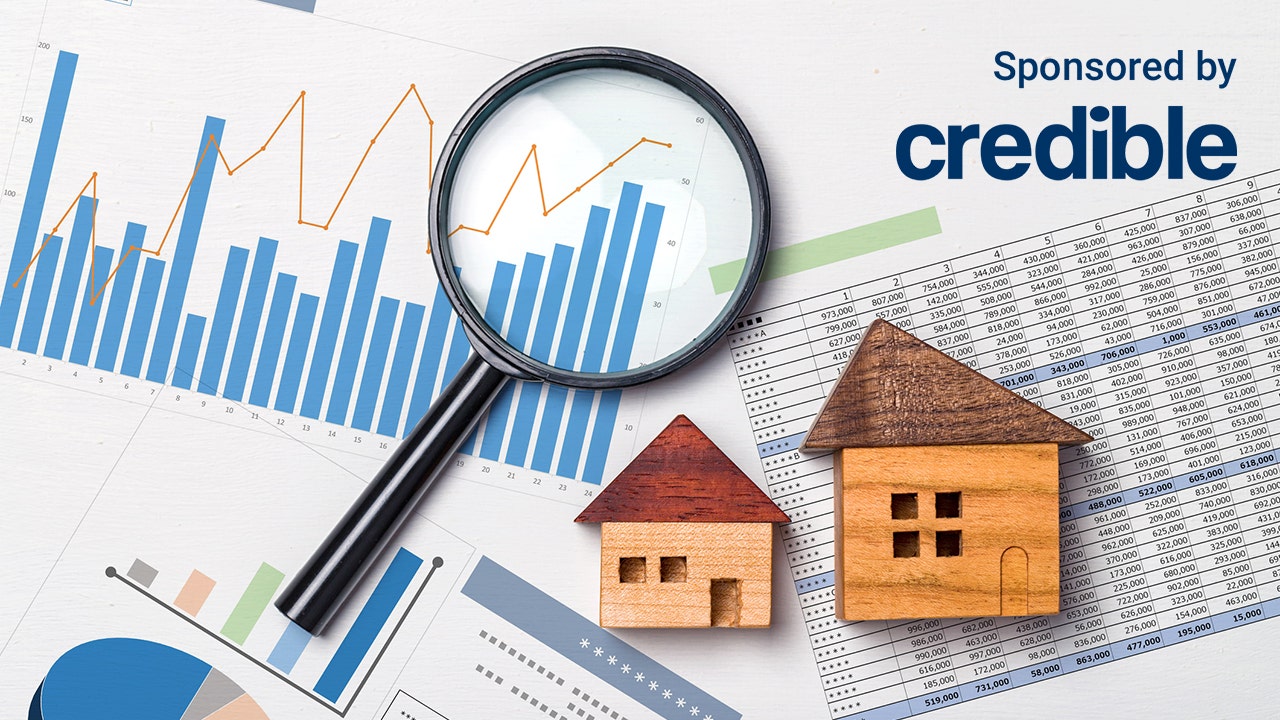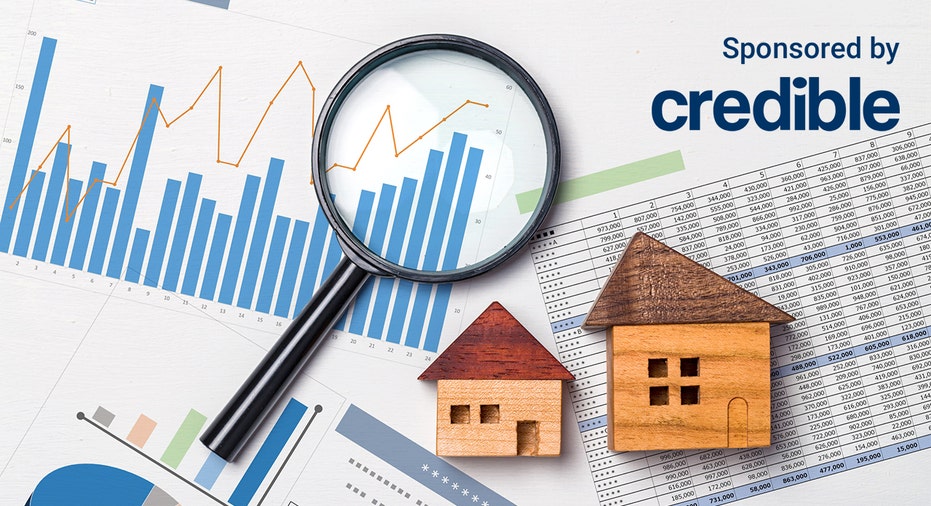Finance
Today’s 30-year mortgage rates hold steady while 15-year rates rise | March 26, 2024
Published
1 year agoon

Our goal here at Credible Operations, Inc., NMLS Number 1681276, referred to as “Credible” below, is to give you the tools and confidence you need to improve your finances. Although we do promote products from our partner lenders who compensate us for our services, all opinions are our own.

Mortgage rates fluctuate almost daily based on economic conditions. Here are today’s mortgage rates and what you need to know about getting the best rate. (iStock)
The interest rate on a 30-year fixed-rate mortgage is 7.000% as of March 26, which is unchanged from yesterday. Additionally, the interest rate on a 15-year fixed-rate mortgage is 6.125%, which is 0.125 percentage points higher than yesterday.
With mortgage rates changing daily, it’s a good idea to check today’s rate before applying for a loan. It’s also important to compare different lenders’ current interest rates, terms, and fees to ensure you get the best deal.
Rates last updated on March 26, 2024. Rates are based on the assumptions shown here. Actual rates may vary. Credible, a personal finance marketplace, has 5,000 Trustpilot reviews with an average star rating of 4.7 (out of a possible 5.0).
How do mortgage rates work?
When you take out a mortgage loan to purchase a home, you’re borrowing money from a lender. In order for that lender to make a profit and reduce risk to itself, it will charge interest on the principal — that is, the amount you borrowed.
Expressed as a percentage, a mortgage interest rate is essentially the cost of borrowing money. It can vary based on several factors, such as your credit score, debt-to-income ratio (DTI), down payment, loan amount, and repayment term.
After getting a mortgage, you’ll typically receive an amortization schedule, which shows your payment schedule over the life of the loan. It also indicates how much of each payment goes toward the principal balance versus the interest.
Near the beginning of the loan term, you’ll spend more money on interest and less on the principal balance. As you approach the end of the repayment term, you’ll pay more toward the principal and less toward interest.
Your mortgage interest rate can be either fixed or adjustable. With a fixed-rate mortgage, the rate will be consistent for the duration of the loan. With an adjustable-rate mortgage (ARM), the interest rate can fluctuate with the market.
Keep in mind that a mortgage’s interest rate is not the same as its annual percentage rate (APR). This is because an APR includes both the interest rate and any other lender fees or charges.
Mortgage rates change frequently — sometimes on a daily basis. Inflation plays a significant role in these fluctuations. Interest rates tend to rise in periods of high inflation, whereas they tend to drop or remain roughly the same in times of low inflation. Other factors, like the economic climate, demand, and inventory can also impact the current average mortgage rates.
To find great mortgage rates, start by using Credible’s secured website, which can show you current mortgage rates from multiple lenders without affecting your credit score. You can also use Credible’s mortgage calculator to estimate your monthly mortgage payments.
What determines the mortgage rate?
Mortgage lenders typically determine the interest rate on a case-by-case basis. Generally, they reserve the lowest rates for low-risk borrowers — that is, those with a higher credit score, income, and down payment amount. Here are some other personal factors that may determine your mortgage rate:
- Location of the home
- Price of the home
- Your credit score and credit history
- Loan term
- Loan type (e.g., conventional or FHA)
- Interest rate type (fixed or adjustable)
- Down payment amount
- Loan-to-value (LTV) ratio
- DTI
Other indirect factors that may determine the mortgage rate include:
- Current economic conditions
- Rate of inflation
- Market conditions
- Housing construction supply, demand, and costs
- Consumer spending
- Stock market
- 10-year Treasury yields
- Federal Reserve policies
- Current employment rate
How to compare mortgage rates
Along with certain economic and personal factors, the lender you choose can also affect your mortgage rate. Some lenders have higher average mortgage rates than others, regardless of your credit or financial situation. That’s why it’s important to compare lenders and loan offers.
Here are some of the best ways to compare mortgage rates and ensure you get the best one:
- Shop around for lenders: Compare several lenders to find the best rates and lowest fees. Even if the rate is only lower by a few basis points, it could still save you thousands of dollars over the life of the loan.
- Get several loan estimates: A loan estimate comes with a more personalized rate and fees based on factors like income, employment, and the property’s location. Review and compare loan estimates from several lenders.
- Get pre-approved for a mortgage: Pre-approval doesn’t guarantee you’ll get a loan, but it can give you a better idea of what you qualify for and at what interest rate. You’ll need to complete an application and undergo a hard credit check.
- Consider a mortgage rate lock: A mortgage rate lock lets you lock in the current mortgage rate for a certain amount of time — often between 30 and 90 days. During this time, you can continue shopping around for a home without worrying about the rate changing.
- Choose between an adjustable- and fixed-rate mortgage: The interest rate type can affect how much you pay over time, so consider your options carefully.
One other way to compare mortgage rates is with a mortgage calculator. Use a calculator to determine your monthly payment amount and the total cost of the loan. Just remember, certain fees like homeowners insurance or taxes might not be included in the calculations.
Here’s a simple example of what a 15-year fixed-rate mortgage might look like versus a 30-year fixed-rate mortgage:
15-year fixed-rate
- Loan amount: $300,000
- Interest rate: 6.29%
- Monthly payment: $2,579
- Total interest charges: $164,186
- Total loan amount: $464,186
30-year fixed-rate
- Loan amount: $300,000
- Interest rate: 6.89%
- Monthly payment: $1,974
- Total interest charges: $410,566
- Total loan amount: $710,565
Pros and cons of mortgages
If you’re thinking about taking out a mortgage, here are some benefits to consider:
- Predictable monthly payments: Fixed-rate mortgage loans come with a set interest rate that doesn’t change over the life of the loan. This means more consistent monthly payments.
- Potentially low interest rates: With good credit and a high down payment, you could get a competitive interest rate. Adjustable-rate mortgages may also come with a lower initial interest rate than fixed-rate loans.
- Tax benefits: Having a mortgage could make you eligible for certain tax benefits, such as a mortgage interest deduction.
- Potential asset: Real estate is often considered an asset. As you pay down your loan, you can also build home equity, which you can use for other things like debt consolidation or home improvement projects.
- Credit score boost: With on-time payments, you can build your credit score.
And here are some of the biggest downsides of getting a mortgage:
- Expensive fees and interest: You could end up paying thousands of dollars in interest and other fees over the life of the loan. You will also be responsible for maintenance, property taxes, and homeowners insurance.
- Long-term debt: Taking out a mortgage is a major financial commitment. Typical loan terms are 10, 15, 20, and 30 years.
- Potential rate changes: If you get an adjustable rate, the interest rate could increase.
How to qualify for a mortgage
Requirements vary by lender, but here are the typical steps to qualify for a mortgage:
- Have steady employment and income: You’ll need to provide proof of income when applying for a home loan. This may include money from your regular job, alimony, military benefits, commissions, or Social Security payments. You may also need to provide proof of at least two years’ worth of employment at your current company.
- Review any assets: Lenders consider your assets when deciding whether to lend you money. Common assets include money in your bank account or investment accounts.
- Know your DTI: Your DTI is the percentage of your gross monthly income that goes toward your monthly debts — like installment loans, lines of credit, or rent. The lower your DTI, the better your approval odds.
- Check your credit score: To get the best mortgage rate possible, you’ll need to have good credit. However, each loan type has a different credit score requirement. For example, you’ll need a credit score of 580 or higher to qualify for an FHA loan with a 3.5% down payment.
- Know the property type: During the loan application process, you may need to specify whether the home you want to buy is your primary residence. Lenders often view a primary residence as less risky, so they may have more lenient requirements than if you were to get a secondary or investment property.
- Choose the loan type: Many types of mortgage loans exist, including conventional loans, VA loans, USDA loans, FHA loans, and jumbo loans. Consider your options and pick the best one for your needs.
- Prepare for upfront and closing costs: Depending on the loan type, you may need to make a down payment. The exact amount depends on the loan type and lender. A USDA loan, for example, has no minimum down payment requirement for eligible buyers. With a conventional loan, you’ll need to put down 20% to avoid private mortgage insurance (PMI). You may also be responsible for paying any closing costs when signing for the loan.
How to apply for a mortgage
Here are the basic steps to apply for a mortgage, and what you can typically expect during the process:
- Choose a lender: Compare several lenders to see the types of loans they offer, their average mortgage rates, repayment terms, and fees. Also, check if they offer any down payment assistance programs or closing cost credits.
- Get pre-approved: Complete the pre-approval process to boost your chances of getting your dream home. You’ll need identifying documents, as well as documents verifying your employment, income, assets, and debts.
- Submit a formal application: Complete your chosen lender’s application process — either in person or online — and upload any required documents.
- Wait for the lender to process your loan: It can take some time for the lender to review your application and make a decision. In some cases, they may request additional information about your finances, assets, or liabilities. Provide this information as soon as possible to prevent delays.
- Complete the closing process: If approved for a loan, you’ll receive a closing disclosure with information about the loan and any closing costs. Review it, pay the down payment and closing costs, and sign the final loan documents. Some lenders have an online closing process, while others require you to go in person. If you are not approved, you can talk to your lender to get more information and determine how you can remedy any issues.
How to refinance a mortgage
Refinancing your mortgage lets you trade your current loan for a new one. It does not mean taking out a second loan. You will also still be responsible for making payments on the refinanced loan.
You might want to refinance your mortgage if you:
- Want a lower interest rate or different rate type
- Are looking for a shorter repayment term so you can pay off the loan sooner
- Need a smaller monthly payment
- Want to remove the PMI from your loan
- Need to use the equity for things like home improvement or debt consolidation (cash-out refinancing)
The refinancing process is similar to the process you follow for the original loan. Here are the basic steps:
- Choose the type of refinancing you want.
- Compare lenders for the best rates.
- Complete the application process.
- Wait for the lender to review your application.
- Provide supporting documentation (if requested).
- Complete the home appraisal.
- Proceed to closing, review the loan documents, and pay any closing costs.
How to access your home’s equity
If you need to tap into your home’s equity to pay off debt, fund a renovation, or cover an emergency expense, there are two popular options to choose from: a home equity loan and a home equity line of credit (HELOC). Both a home equity loan and a HELOC allow you to borrow against your home’s equity but a home equity loan comes in the form of a lump sum payment and a HELOC is a revolving line of credit.
These two loan types have some other key similarities and differences in how they work:
| Home equity loan | Home equity line of credit (HELOC) | |
| Interest rate | Fixed | Variable |
| Monthly payment amount | Fixed | Variable |
| Closing costs and fees | Yes | Yes, might be lower than other loan types |
| Repayment period | Typically 5-30 years | Typically 10-20 years |
FAQ
What is a rate lock?
Interest rates on mortgages fluctuate all the time, but a rate lock allows you to lock in your current rate for a set amount of time. This ensures you get the rate you want as you complete the homebuying process.
What are mortgage points?
Mortgage points are a type of prepaid interest that you can pay upfront — often as part of your closing costs — for a lower overall interest rate. This can lower your APR and monthly payments.
What are closing costs?
Closing costs are the fees you, as the buyer, need to pay before getting a loan. Common fees include attorney fees, home appraisal fees, origination fees, and application fees.
If you’re trying to find the right mortgage rate, consider using Credible. You can use Credible’s free online tool to easily compare multiple lenders and see prequalified rates in just a few minutes.
You may like
Finance
Investors are piling into big, short Treasury bets with Warren Buffett
Published
3 hours agoon
June 1, 2025

Investors always pay close attention to bonds, and what the latest movement in prices and yields is saying about the economy. Right now, the action is telling investors to stick to the shorter-end of the fixed-income market with their maturities.
“There’s lots of concern and volatility, but on the short and middle end, we’re seeing less volatility and stable yields,” Joanna Gallegos, CEO and founder of bond ETF company BondBloxx, said on CNBC’s “ETF Edge.”
The 3-month T-Bill right now is paying above 4.3%, annualized. The two-year is paying 3.9% while the 10-year is offering about 4.4%.
ETF flows in 2025 show that it’s the ultrashort opportunity that is attracting the most investors. The iShares 0-3 Month Treasury Bond ETF (SGOV) and SPDR Bloomberg 1-3 T-Bill ETF (BIL) are both among the top 10 ETFs in investor flows this year, taking in over $25 billion in assets. Only Vanguard Group’s S&P 500 ETF (VOO) has taken in more new money from investors this year than SGOV, according to ETFAction.com data. Vanguard’s Short Term Bond ETF (BSV) is not far behind, with over $4 billion in flows this year, placing with the top 20 among all ETFs in year-to-date flows.
“Long duration just doesn’t work right now” said Todd Sohn, senior ETF and technical strategist at Strategas Securities, on “ETF Edge.”
It would seem that Warren Buffett agrees, with Berkshire Hathaway doubling its ownership of T-bills and now owning 5% of all short-term Treasuries, according to a JPMorgan report.

Investors including Warren Buffett have been piling into short term Treasuries.
“The volatility has been on the long end,” Gallegos said. “The 20-year has gone from negative to positive five times so far this year,” she added.
The bond volatility comes nine months after the Fed’s began cutting rates, a campaign it has since paused amid concerns about the potential for resurgent inflation due to tariffs. Broader market concerns about government spending and deficit levels, especially with a major tax cut bill on the horizon, have added to bond market jitters.
Long-term treasuries and long-term corporate bonds have posted negative performance since September, which is very rare, according to Sohn. “The only other time that’s happened in modern times was during the financial crisis,” he said. “It is hard to argue against short term duration bonds right now,” he added.
Sohn is advising clients to steer clear of anything with a duration of longer than seven years, which has a yield in the 4.1% range right now.
Gallegos says she is concerned that amid the bond market volatility, investors aren’t paying enough attention to fixed income as part of their portfolio mix. “My fear is investors are not diversifying their portfolios with bonds today, and investors still have an equity addiction to concentrated broad-based indexes that are overweight certain tech names. They get used to these double-digit returns,” she said.
Volatility in the stock market has been high this year as well. The S&P 500 rose to record levels in February, before falling 20%, hitting a low in April, and then reversing all of those losses more recently. While bonds are an important component of long-term investing to shield a portfolio from stock corrections, Sohn said now is also a time for investors to look beyond the United States with their equity positions.
“International equities are contributing to portfolios like they haven’t done in a decade” he said. “Last year was Japanese equities, this year it is European equities. Investors don’t have to be loaded up on U.S. large cap growth right now,” he said.
The iShares MSCI Eurozone ETF (EZU) is up 25% so far this year. The iShares MSCI Japan ETF (EWJ) Japan ETF is up 25% over the last two years.

Overseas assets have become more popular.
Finance
Apple’s China rival Xiaomi still has major upside, analysts say
Published
6 hours agoon
June 1, 2025
Chinese smartphone company Xiaomi in the last week reported record net profit for a second-straight quarter, bolstering several analysts’ conviction on the Hong Kong-listed stock. In absolute dollar terms, Xiaomi’s earnings are still a fraction of Apple’s . But the Chinese company has a larger smartphone market share in China , and has built an electric vehicle business, while the iPhone maker dropped its car plans . Apple in recent months has also come under pressure from the Trump administration over its overseas supply chain. Apple shares are down 20% year-to-date to around $200. Xiaomi’s have gained more than 45% to 50.95 Hong Kong dollars ($6.50) a share. Following Xiaomi’s earnings report on May 27, Jefferies analysts raised their price target to 73 HKD, up from 69.50 HKD previously — for upside of 43% from Friday’s close. The analysts attributed the company’s earnings beat to outperformance in “AIoT.” The category refers to Xiaomi’s appliances, which incorporate artificial intelligence functions and can be controlled remotely over the internet using an app. Xiaomi’s adjusted net income for the first quarter was 10.68 billion yuan ($1.48 billion), beating the expected 9.48 billion yuan, according to a FactSet analyst poll. Revenue of 111.29 billion yuan also came in above the 108.49 billion yuan predicted by the poll. In smartphones, Xiaomi has become more conservative about the global outlook, but the Jefferies analysts pointed out the company will likely continue to gain market share in the high-end China market with its new Xring O1 chip. Xiaomi officially revealed the chip on May 22 and said it would power its new 15S Pro smartphone, which sells for far less than Apple’s iPhone 16 Pro in China. CEO Lei Jun claimed at the event that Xiaomi’s Xring O1 Apple’s A18 Pro on several metrics, including the ability to operate a game with less heat. Smartphones account for just under 40% of Xiaomi’s revenue. Appliances and other products make up nearly 22%. “We believe appliances represent major upside in the next two years, but [Xiaomi’s electric SUV] YU7 sales will be [the] key [short-term] catalyst,” the Jefferies analysts said. Xiaomi revealed its YU7 SUV at the same May 22 event. While the company didn’t announce a price, it said an official launch would be held in July and that the new car would come with a longer driving range than rival Tesla’s Model Y. “We believe the launch of YU7, scheduled for July 2025, will likely be the most important catalyst for Xiaomi this year,” Morgan Stanley analysts said in a May 27 report. They expect the SUV can garner a higher price point than Xiaomi’s SU7 electric sedan that hit the market last year. “If sales volume is strong, it could help Xiaomi achieve higher ASPs, better margins, and ongoing earnings growth,” the Morgan Stanley analysts said. They rate Xiaomi overweight and have a price target of 62 HKD. In addition to the YU7 release this summer, several analysts said they are looking forward to Xiaomi’s investor day, scheduled for June 3. Those are both potential positive catalysts, Macquarie said. “We believe Xiaomi is a beneficiary of rising EV demand, changing consumer behavior, and industry consolidation in China.” “The company is widening its core business product offerings, expanding overseas and controlling [operating expenses] to drive profitability,” the report said. Macquarie rates the stock outperform, with a price target of 69.32 HKD. JPMorgan analysts kept their neutral rating, however, as they said Xiaomi’s ecosystem-related revenue growth was the slowest among major categories — not supportive of a high valuation in their view. They cautioned that while Apple was able to gain value once services started driving growth instead of hardware, Xiaomi has seen accelerating hardware growth while services has grown more slowly. Their price target is 60 HKD, still about 18% above where the stock closed Friday. — CNBC’s Michael Bloom contributed to this report.
Finance
Why JPMorgan hired NOAA’s Sarah Kapnick as chief climate scientist
Published
1 day agoon
May 31, 2025
Sarah Kapnick started her career in 2004 as an investment banking analyst for Goldman Sachs. She was struck almost immediately by the overlap of financial growth and climate change, and the lack of client advisory around that theme.
Integrating the two, she thought, would help investors understand both the risks and opportunities, and would help them use climate information in finance and business operations. With a degree in theoretical mathematics and geophysical fluid dynamics, Kapnick saw herself as uniquely positioned to take on that challenge.
But first, she had to get deeper into the science.
That led her to more study and then to the National Oceanic and Atmospheric Administration (NOAA), the nation’s scientific and regulatory agency within the U.S. Department of Commerce. Its defined mission is to understand and predict changes in climate, weather, oceans and coasts and to share that knowledge and information with others.
In 2022, Kapnick was appointed NOAA’s chief scientist. Two years later, JPMorgan Chase hired her away, but not as chief sustainability officer, a role common at most large investment banks around the world and a position already filled at JPMorgan.
Rather, Kapnick is JPMorgan’s global head of climate advisory, a unique job she envisioned back in 2004.
Just days before the official start of the North American hurricane season, CNBC spoke with Kapnick from her office at JPMorgan in New York about her current role at the bank and how she’s advising and warning clients.
Here’s the Q&A:
(This interview has been lightly edited for length and clarity.)
Diana Olick, CNBC: Why does JPMorgan need you?
Sarah Kapnick, JPMorgan global head of climate advisory: JPMorgan and banks need climate expertise because there is client demand for understanding climate change, understanding how it affects businesses, and understanding how to plan. Clients want to understand how to create frameworks for thinking about climate change, how to think about it strategically, how to think about it in terms of their operations, how to think about it in terms of their diversification and their long-term business plans.
Everybody’s got a chief sustainability officer. You are not that. What is the difference?
The difference is, I come with a deep background in climate science, but also how that climate science translates into business, into the economy. Working at NOAA for most of my career, NOAA is a science agency, but it’s science agency under the Department of Commerce. And so my job was to understand the future due to physics, but then be able to translate into what does that mean for the economy? What does that mean for economic development? What does that mean for economic output, and how do you use that science to be able to support the future of commerce? So I have this deep thinking that combines all that science, all of that commerce thinking, that economy, how it translates into national security. And so it wraps up all these different issues that people are facing right now and the systematic issues, so that they can understand, how do you navigate through that complexity, and then how do you move forward with all that information at hand?
Give us an example, on a ground level, of what some of that expertise does for investors.
There’s a client that’s concerned about the future of wildfire risk, and so they’re asking, How is wildfire risk unfolding? Why is it not in building codes? How might building codes change in the future? What happens for that? What type of modeling is used for that, what type of observations are used for that? So I can explain to them the whole flow of where is the data? How is the data used in decisions, where do regulations come from. How are they evolving? How might they evolve in the future? So we can look through the various uncertainties of different scenarios of what the world looks like, to make decisions about what to do right now, to be able to prepare for that, or to be able to shift in that preparation over time as uncertainty comes down and more information is known
So are they making investment decisions based on your information?
Yes, they’re making investment decisions. And they’re making decisions of when to invest because sometimes they have a knowledge of something as it’s starting to evolve. They want to act either early or they want to act as more information is known, but they want to know kind of the whole sphere of what the possibilities are and when information will be known or could be known, and what are the conditions that they will know more information, so they can figure out when they want to act, when that threshold of information is that they need to act.
How does that then inform their judgment on their investment, specifically on wildfire?
Because wildfire risk is growing, there’ve been a few events like the Los Angeles wildfires that were recently seen. The questions that I’m getting are could this happen in my location? When will it happen? Will I have advanced notice? How should I change and invest in my infrastructure? How should I think about differences in my infrastructure, my infrastructure construction? Should I be thinking about insurance, different types of insurance? How should I be accessing the capital markets to do this type of work? It’s questions across a range of trying to figure out how to reduce vulnerability, how to reduce financial exposure, but then also, if there are going to be risks in this one location, maybe there are more opportunities in these other locations that are safer, and I should be thinking of them as well. It’s holistically across risk management and thinking through risk and what to do about it, but then also thinking about what opportunities might be emerging as a result of this change in physical conditions in the world.
But you’re not an economist. Do you work with others at JPMorgan to augment that?
Yes, my work is very collaborative. I work across various teams with subject matter experts from different sectors, different industries, different parts of capital, and so I come with my expertise of science and technology and policy and security, and then work with them in whatever sphere that they’re in to be able to deliver the most to the bank that we can for our clients.
With the cuts by the Trump administration to NOAA, to FEMA, to all of the information gathering sources — we’re not seeing some of the things that we normally see in data. How is that affecting your work?
I am looking to what is available for what we need, for whatever issue. I will say that if data is no longer available, we will translate and move into other data sets, use other data sets, and I’m starting to see the development out in certain parts of the private sector to pull in those types of data that used to be available elsewhere. I think that we’re going to see this adjustment period where people search out whatever data it is they need to answer the questions that they have. And there will be opportunities. There’s a ton of startups that are starting to develop in that area, as well as more substantial companies that have some of those data sets. They’re starting to make them available, but there’s going to be this adjustment period as people figure out where they’re going to get the information that they need, because many market decisions or financial decisions are based on certain data sets that people thought would always be there.
But the government data was considered the top, irrefutable, best data there was. Now, how do we know, when going to the private sector, that this data is going to be as credible as government data?
There’s going to be an adjustment period as people figure out what data sets to trust and what not to trust, and what they want to be using. This is a point in time where there is going to be adjustment because something that everyone got used to working with, they now won’t have that. And that is a question that I’m getting from a lot of clients, of what data set should I be looking for? How should I be assessing this problem? Do I build in-house teams now to be able to assess this information that I didn’t have before? And I’m starting to see that occurring across different sectors, where people are increasingly having their own meteorologist, their own climatologist, to be able to help guide them through some of these decisions.
Final thoughts?
Climate change isn’t something that is going to happen in the future and impact finance in the future. It’s something that is a future risk that is now actually finding us in the bottom line today.

Investors are piling into big, short Treasury bets with Warren Buffett

Apple’s China rival Xiaomi still has major upside, analysts say

Social Security checks may be smaller for some as garnishments begin

New 2023 K-1 instructions stir the CAMT pot for partnerships and corporations

The Essential Practice of Bank and Credit Card Statement Reconciliation

Are American progressives making themselves sad?
Trending
-

 Accounting1 week ago
Accounting1 week agoHouse tax bill includes provision eliminating PCAOB
-

 Finance1 week ago
Finance1 week agoPersonal finance app Monarch raises $75 million
-

 Personal Finance1 week ago
Personal Finance1 week agoHow appealing property taxes can benefit new homeowners
-

 Blog Post1 week ago
Blog Post1 week agoHow to Implement Internal Controls to Prevent Business Fraud
-

 Accounting1 week ago
Accounting1 week agoIs a fraud pandemic around the corner?
-

 Economics1 week ago
Economics1 week agoTrump greenlights Nippon merger with US Steel
-

 Personal Finance1 week ago
Personal Finance1 week agoHow to pay college tuition bills with your 529 plan
-

 Economics4 days ago
Economics4 days agoElon Musk says Trump’s spending bill undermines the work DOGE has been doing
